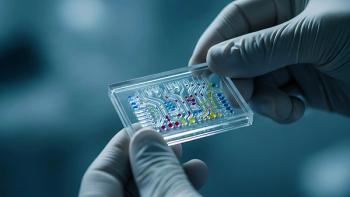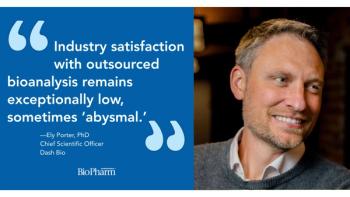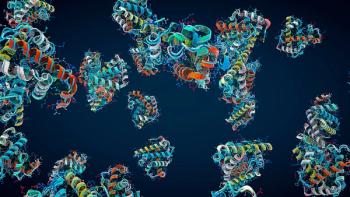
- BioPharm International-02-01-2019
- Volume 32
- Issue 2
Analytical Method Transfer: Don’t Oversimplify
When transferring a method from R&D to QC, success hinges on discovering where “the best” and “the most reliable” intersect.
Analytical method transfer suffers from many of the same problems that plague technology transfer in general. All too often, a method may work well in the R&D lab as a characterization test, but fails when taken to a wider stage, where reproducibility is key.
In addition, incomplete information may be shared between the two organizations working on the transfer, and details on how to carry out standard operating procedures may be given short shrift. Partners may also fail to consider critical points (e.g., whether data interpretation software meets FDA regulations). As Berangere Tissot, general manager with SGS Life Sciences says, “The devil is in the details.” Tissot, who is a subject matter expert on protein and glycoprotein characterization and complex method validations, recently shared best practices with BioPharm International.
BioPharm: What mistakes do people typically make with regard to analytical method transfer for biologics?
Tissot: The most common mistake people make is underestimating the complexity of analytical method transfer, particularly for biologics. The problem that will jeopardize any analytical method transfer, whether at very early or late stages, is the failure to convey the ‘know how’ in documentation that is sent to the transfer partner. Often, instructions are very detailed on some aspects of the method yet key information is missing because it is not considered critically relevant. It’s important to remember that the manipulation of a biologic is very different from that of a small molecule. For some assays, sample preparation is key to the method, yet it is often the least described part of the methodology. Even in cases where it is well described, important elements are often missing. This can undermine the difficult challenge of reproducing an assay with consistency and robustness.
Another area where insufficient knowledge transfer often occurs is when a company has to validate, or ask its contract development and manufacturing organization (CDMO) partner to validate, what was developed as an early phase characterization assay. In many cases, 50–90% of the information that is needed in order to validate the method is simply not there, which makes the next step of transferring that method from development to a quality control (QC) environment, a real challenge.
BioPharm: How and what kind of information must be conveyed, and what kind of mindset is needed to ensure that key issues are not left out?
Tissot: Thinking in terms of developing what will later be validated allows one to have more control over the analytical development stage. When you develop an R&D method with the idea that it could be a QC test at some point in the future, you will do it differently from the way you would develop a characterization test that will remain an R&D characterization test.
When you develop a method that will be transferred to QC or to another lab, you would want to focus on simplifying sample preparation and data acquisition-for example, you would not want to have a 60-step process for sample preparation. You may also consider, whenever possible, to make the method unbiased to any specific type or brand of instrumentation.
BioPharm: Do R&D scientists have to think like QC technicians?
Tissot: These two categories have different skillsets and mindsets. It does not mean they are incompatible, but it requires some training to move from one to the other. When you work in QC, you have to deal with many restrictions on what you can change. Scientists who are developing analytical methods in R&D typically do not have to consider these restrictions. However, if the method has any chance of being part of a release panel, they should at least know what these restrictions are and conceive of an assay that takes them into account.
For example, they shouldn’t specify the use of exotic enzymes, however more specific or appropriate they might be, because those materials might pose availability and quality consistency problems that will affect the method’s continuity and robustness. For any enzyme used in testing, consistency in quality and multiple sources of supply would be paramount. Early phase analytical teams are developing a new method because they are after either new or more precise information, but what will work best for moving the method along in R&D is unlikely to work in the QC environment. Thus, it is very important to think about that translation at the very beginning of assay development.
We always ask clients, when we are developing methods for them, whether they envision the method being used as a release assay at some point in the future, or whether they see it as having to be validated. Even if no one can be certain, just the possibility that it might is important for devising the appropriate strategy around the method development.
BioPharm: But how can one know this at early R&D stages?
Tissot: You don’t, at least not with absolute conviction. It is very difficult to know at this stage, but you may have some sense of whether this approach will be needed, and that sense needs to be communicated to whoever is working on developing the assay so that the method is built on a solid basis and with the appropriate mindset.
This is the major difficulty with transferring analytical methods. Creativity is valued and imagining the best possible way to approach the method is very important. However, analytical developers should also consider the most reliable way of performing the assay, if it is to be implemented in GMP environments and QC labs later. Situations will come up where these two priorities cannot be matched, and some compromises will be needed.
BioPharm: Is this a part of risk management?
Tissot: It is essential to developing a good risk management strategy around the method itself and its lifecycle. Imagine you are working on the development of a characterization assay for N-glycan structure elucidation that will be used for a drug that has a very complex glycosylation (e.g. for a replacement enzyme, where you know that some form of derivatization or glycosylation will be key to the product’s functionality). In this situation, the method, which should normally belong to the characterization panel only, will probably end up being the best approach for monitoring and controlling a critical quality attribute (CQA) of the product.
For the purpose of the characterization assay, you are trying to fully understand the complexity of the N-glycan structures. In order to get detailed results, the method might be complex and convoluted. Repeatability or robustness will not be evaluated and rightly so, if this method is just for characterization. The method efficiency will be as good as the scientist carrying out the assay, which is very common in R&D environment. However, if you haven’t considered the future use of the assay and built some preliminary risk management (e.g., having some specificity, repeatability, and evaluation of the critical parameters to control in the sample preparation done at the R&D phase), you will need to put a remediation plan in place, and then develop a translation phase for that method, to demonstrate that the assay can be brought into QC and eliminate most of the risks that would be linked to a complex procedure.
BioPharm: Do you need to staff these projects in a special way?
Tissot: In very small companies, there may not even be a QC or an R&D department. At many of the medium-size biopharma companies, these groups may not be actively working together. However, a growing number of large biopharmaceutical companies now have groups in between R&D and QC that focus on bridging these two groups and assisting them with the transition of R&D methods in the QC environment. These ‘translation’ groups generally include people who are educated in QC and understand all the restrictions of QC work, yet who are well versed in R&D, to find that middle ground.
BioPharm: When did this start?
Tissot: We started to see it a few years ago, and this trend is likely to continue to grow.
BioPharm: You mentioned the importance of describing all steps in detail. Why should that be necessary?
Tissot: This is the key reason why these transfer or transition projects fail. Let me describe one situation which we encountered where we received an R&D method to transfer in our lab and validate to cGMP. The protocol had many details around the sample preparation but failed to mention the fact that the protein of interest was adsorbed on plastic surfaces, and therefore was adsorbed on plastic microtubes. It took us some time to pin the difference observed in recovery to this very basic fact. Nowhere in the protocol were glass containers mentioned, because it had been so engrained in the minds of the scientists who worked with this protein that ‘it went without saying.’
BioPharm: How do you ensure that clients provide this information?
Tissot: We spend a lot of time talking with the client, the scientists who developed the assay, and reviewing the method before we even take the work in. We need to understand each of the steps of the method and evaluate how much of undisclosed details are at each of these steps. It may sound tedious and we may ask questions that seem unimportant, but all of this is essential to understanding what is critical to the method and what is not.
In general, the more we know upfront, the less we have to ask later. We need to be proactive about the transfer and clients generally understand that a lot of preliminary work is required in order to maximize the efficiency of the transition and the chance of validating a robust and reliable assay.
BioPharm: Is information technology a factor?
Tissot: Yes, it is a crucial factor. The requirement for compliance to 21 Code of Federal Register (CFR) Part 11 for R&D methods is not as critical as it is for cGMP methods.
For some high-end methods, it is still very possible that the software used to analyze data is not yet Part 11 compliant. When such a method needs to be validated, the risk management has also to account for the workarounds to be implemented around the data acquisition and interpretation. This is not trivial and requires close collaboration between the scientific staff, quality assurance and computerized system validation groups, and sometimes, the instrument manufacturer. This consideration needs to be more apparent to R&D scientists, with the understanding that the method might eventually be pushed to the QC lab.
BioPharm: How can both partners minimize risk?
Tissot: Mostly by opening up lines of communication and work around the language barrier between R&D and QC. In any circumstance, take a stepwise approach while evaluating whether the method can be transferred to GMP. Our first phase of evaluation is performed on our instrumentation, leveraging our ability to do R&D in a regulated environment. Based on that first evaluation, we define critical checkpoints (i.e., what may pose problem to specificity, repeatability or any other critical validation requirement) and parameters which may require optimization or adjustments. We evaluate critical reagents and work our way through defining multiple suppliers to briefly assess robustness , whenever necessary. The method is now in a “state” where it can be evaluated more in depth for its applicability to release.
What will be investigated next will depend on the use of the assay: whether it is for an identity test, the monitoring of CQA, or for quantitative residual testing. Each application will have a set of parameters for which specifications would need to be defined. Based on these, we will either optimize further or go straight to a pre-validation or pre-qualification study to see how the method fares and what could be the targeted acceptance criteria. What is needed here will also depend on the clinical phase for which the method needs to be validated. Stringency on acceptance criteria and extent of the study will be different depending on whether the product is in Phase I or III. Once everything has been empirically assessed, we can then work on a validation protocol.
BioPharm: Have you ever had to ‘just say no’ to a project?
Tissot: It is always difficult to say no because most of the time, it is not that the method is impossible to work with, but rather the requirements that are coming with the transfer. For example, when companies want to validate one of their R&D methods, but then ask for it to be validated within a week, they need to understand that this is not likely to be achievable. Rushing to such a critical step in their analytical development is likely to result in them shooting themselves in the foot and incurring the risk of running into extensive and expensive remediation work.
Success requires a lot of homework and careful, educated evaluation of method from a preparation, analytical and software/IT standpoint. The focus cannot be only on the instrument acquiring the data, but must include the software analyzing those data and the way the data are being recorded. Everything must be considered.
BioPharm: How can you do the work and comply when the software isn’t Part 11 compliant?
Tissot: It requires creativity and a good handle on the compliance and regulatory requirements. Analytical instrument manufacturers are working on solutions. One can assume that there will be fewer and fewer of these gaps in the very near future.
Article Details
BioPharm International
Vol. 32, No. 2
February 2019
Pages: 30–32
Citation
When referring to this article, please cite it as A. Shanley, “Analytical Method Transfer: Don’t Oversimplify," BioPharm International 32 (2) 2019.
Articles in this issue
almost 7 years ago
Small-Batch Aseptic Fill/Finish Systemalmost 7 years ago
Supply Chain Challenges for Single-Use Systemsalmost 7 years ago
Sustainability in Disposal of Single-Use Systemsalmost 7 years ago
Sterile Boot Coversalmost 7 years ago
Innovations Maintain the Cold Chainalmost 7 years ago
What’s New in Lab Automationalmost 7 years ago
Automation in the Lab: What to Consideralmost 7 years ago
As Drug Spending Slows, Investment Must Pick Upalmost 7 years ago
Effective Root Cause Determinationalmost 7 years ago
FDA Promotes Quality Standards to Reduce ShortagesNewsletter
Stay at the forefront of biopharmaceutical innovation—subscribe to BioPharm International for expert insights on drug development, manufacturing, compliance, and more.




